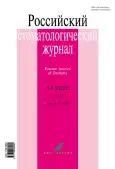Анализ боковых телерентгенограмм у пациентов детского возраста с вертикальной дизокклюзией зубных рядов III степени
- Авторы: Али А.Э.1, Водолацкий В.М.1, Григорьян Э.Г.1
-
Учреждения:
- ФГБОУ ВО «Ставропольский государственный медицинский университет» Минздрава России
- Выпуск: Том 24, № 5 (2020)
- Страницы: 297-300
- Раздел: Клинические исследования
- URL: https://journals.rcsi.science/1728-2802/article/view/61027
- DOI: https://doi.org/10.17816/1728-2802-2020-24-5-297-300
- ID: 61027
Цитировать
Полный текст
Аннотация
Цель исследования — изучение боковых телерентгенограмм у 43 пациентов с вертикальной дизокклюзией зубных рядов III степени в возрасте от 7 до 18 лет.
Материал и методы. На боковых телерентгенограммах изучались показатели углов SN-NL, SN-ML, NL-ML, показывающие соотношения верхней и нижней челюсти относительно основания черепа и относительно друг друга.
Наибольшие показатели угла SN-NL были отмечены у детей 1-й группы в возрасте 18 лет — 9,0°, во 2-й группе в возрасте 18 лет — 9,3°, в 3-й группе в возрасте 17 лет — 8,9°. Наименьшие показатели угла SN-NL наблюдались у детей 1-й группы в возрасте 7, 8, 10 лет — 7,5°, во 2-й группе в возрасте 7 лет — 8,5°, в 3-й группе в возрасте 7 лет — 8,4°.
Наибольшие показатели угла SN-МL отмечены у детей 1-й группы в возрасте 15, 16, 17, 18 лет — 33°, во 2-й группе в возрасте 18 лет — 37°, в 3-й группе в возрасте 17, 18 лет — 36°. Наименьшие показатели угла SN-МL были у детей 1-й группы в возрасте 12 лет — 31°, во 2-й группе в возрасте 11 лет — 33°, в 3-й группе в возрасте 11, 12, 13 лет — 34°. Наибольшие показатели угла NL-ML — 34°, отмечены у детей 17 лет из 1-й группы, во 2-й группе в возрасте 17, 18 лет — 33°, в 3-й группе в возрасте 13, 14 и 18 лет — 30°. У детей 1-й группы в возрасте 7, 8, 11 лет, 2-й группы в возрасте 9, 10 лет и 3-й группы в возрасте 8 лет определены наименьшие показатели угла NL-ML — 28, 28, 27° соответственно.
Результаты. В результате проведенного исследования отмечено, что у детей с вертикальной дизокклюзией зубных рядов III степени углы SN-NL, SN-ML, NL-ML имеют высокие показатели, что характеризует вертикальный тип роста черепа.
Заключение. Данные боковых ТРГ по методу A.M. Schwarz у пациентов с вертикальной дизокклюзией зубных рядов III степени показатели углов SN-NL, SN-ML, NL-ML характеризует вертикальный тип роста черепа.
Ключевые слова
Полный текст
Открыть статью на сайте журналаОб авторах
А. Э. Али
ФГБОУ ВО «Ставропольский государственный медицинский университет» Минздрава России
Автор, ответственный за переписку.
Email: vmv.st@yandex.ru
Россия, 355017, г. Ставрополь, ул.Мира,310
В. М. Водолацкий
ФГБОУ ВО «Ставропольский государственный медицинский университет» Минздрава России
Email: vmv.st@yandex.ru
Доктор медицинских наук, профессор, заведующий кафедрой
Россия, 355017, г. Ставрополь, ул.Мира,310Э. Г. Григорьян
ФГБОУ ВО «Ставропольский государственный медицинский университет» Минздрава России
Email: vmv.st@yandex.ru
Россия, 355017, г. Ставрополь, ул.Мира,310
Список литературы
- Gagloeva NF, Nalbandyan LV, Vodolatskii VM. Research of orthopantomograms of patients with open bite. In: Modern methods of diagnosis, treatment and prevention of dental diseases: 54th National Russian Dental Scientific and Practical Conference: collection of materials. Stavropol; 2018. p. 68–70. (in Russian)
- Fadeev RA, Timchenko VV. The structural features of the face in patients with vertical malocclusion. Pediatr. 2017;8(1):M336–M337. (in Russian)
- Myagkova NV, Bimbas ES. Analysis of the development of the facial skeleton and soft tissue profile in growing and adult patients with morphological features of skeletal forms of mesial occlusion according to the G.W. Arnett method. Ortodontiya. 2015;(3):11–17. (in Russian)
- Gioeva YuA, Topol'nitskii OZ, Alimova AV. 3D cephalometry as a method for analyzing the results of treatment of patients with grade III mesial occlusion. Rossiiskaya stomatologiya. 2015;(1):39–40. (in Russian)
- Gioeva YuA, Matveeva MN. Analysis of cone-beam computed tomography data in patients aged 9–15 years with mesial occlusion of the dentition. Orthodontia. 2013;(2):36–37. (in Russian)
- Ul'yanova LG, Stepanov GV, Postnikov MA. Analysis of the results of treatment of patients with mesial occlusion using telerentgenograms of the head in a lateral projection. Orthodontia. 2012;(1):96–96. (in Russian)
- do Amaral BA, Gondim Filgueira AC, da Silva-Neto JP, de Lima KC. Relationship between normative and self-perceived criteria for orthodontic treatment need and satisfaction with esthetics and mastication in adolescents. Am J Orthod Dentofacial Orthop. 2020;157(1):42–48.e2. doi: 10.1016/j.ajodo.2019.01.025.
- Tseng LLY, Chang CH, Roberts WE. Diagnosis and conservative treatment of skeletal Class III malocclusion with anterior crossbite and asymmetric maxillary crowding. Am J Orthod Dentofacial Orthop. 2016;149(4):555–566. doi: 10.1016/j.ajodo.2015.04.042.
- Choi YJ, Kim DJ, Nam J, et al. Cephalometric configuration of the occlusal plane in patients with anterior open bite. Am J Orthod Dentofacial Orthop. 2016;149(3):391–400. doi: 10.1016/j.ajodo.2015.08.020.
- Scheffler NR, Proffit WR, Phillips C. Outcomes and stability in patients with anterior open bite and long anterior face height treated with temporary anchorage devices and a maxillary intrusion splint. Am J Orthod Dentofacial Orthop. 2014;146(5):594–602. doi: 10.1016/j.ajodo.2014.07.020.
- Kale Varlık S, Onur Alpakan Ö, Türköz Ç. Deepbite correction with incisor intrusion in adults: a long-term cephalometric study. Am J Orthod Den-tofacial Orthop. 2013; 144(3):414–419. doi: 10.1016/j.ajodo.2013.04.014.
- Rodrigues AF, Fraga MR, Vitral RW. Computed tomography evaluation of the temporomandibular joint in Class II Division 1 and Class III malocclusion patients: condylar symmetry and condyle-fossa relationship. Am J Orthod Dentofacial Orthop. 2009;136(2): 199–206. doi: 10.1016/j.ajodo.2007.07.033.
Дополнительные файлы







